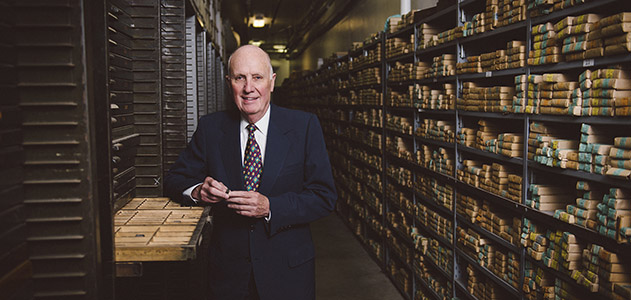The Arion Press—named after the legendary Greek poet who was saved from the sea by a dolphin—remains a small operation, employing a dozen people as printers, bookbinders, editors and in other publishing roles. But it has outsize influence in the publishing world due to its unique, hand-crafted books.

Andrew Hoyem in the depths of Arion Press, a leading publisher of fine-press books that was founded in 1974. Photo by ToniBird Photography
By Paul Duclos
Published: February, 2015
The Arion Press—named after the legendary Greek poet who was saved from the sea by a dolphin—remains a small operation, employing a dozen people as printers, bookbinders, editors and in other publishing roles. But it has outsize influence in the publishing world due to its unique, hand-crafted books.
The creative spirit of Arion Press is Andrew Hoyem, who founded the press in 1974. Considered one of the most accomplished printers of today, Hoyem is also a published poet and exhibited artist who occasionally includes his own writings and drawings in Arion books. The concepts for all Arion publications originate with Hoyem, who first chooses existing texts or commissions new work from writers and artists he admires. Then, he designs the books, including their bindings and typography. In the press’ livre d’artiste series, he has worked closely with distinguished artists, many of whom come to the press in San Francisco to work with him on projects.
Here, in an exclusive interview with Cultural Currents, Hoyem shares a few of his reflections and insights on hand-crafted value.
Bay Crossings: Traditional mass market book publishers have been under pressure from a variety of fronts of late, including Amazon’s predatory discounting and the advent of e-readers. How does Arion fit into this milieu?
Andrew Hoyem: I believe Amazon and e-readers have no effect on our business. People who want Arion Press books want physical books and appreciate our books as works of art and craft. Looking at the larger picture, there is evidence that fatigue with reading on the screen drives the renewal of interest in the physical book.
BC: How does Arion determine which “lost texts” deserve resurrection? And once saved, are they popular with your readers?
Hoyem: We have wide-ranging tastes and interests. Rather than “lost texts,” we prefer to characterize such titles as “rediscovered texts.” They counteract the impression that Arion Press only publishes masterpieces of literature, what might be called “chestnuts.” Examples include the first English detective story, The Moonstone; an important novel from the 1950s, The Sundial; a work of pulp fiction, South of Heaven; a satire about quack medicine, Tono-Bungay; and the French interior monologue Journey Round My Room. Our collectors seem to appreciate having the overlooked brought to their attention.
BC: Your books obviously become family heirlooms, and some appreciate in value in secondary markets. Can you describe the other advantages of becoming a subscriber?
Hoyem: We downplay inheritance and escalating value. Furthermore, the secondary market value for limited edition books is very hard to predict. These are not investments. Subscribers take pleasure in owning books made to the highest standards and reading them. The books are sturdy, meant to be handled with clean hands, not used as coasters or hors d’oeuvres trays. Subscribers can look forward to receiving about three books each year, each of them different from the rest in terms of design, format, artworks and, in most cases, subject matter.
BC: Given the small scale of your operations, how do you retain craftspeople and find new talent to keep this tradition going?
Hoyem: We are a dozen people. Many have been with us for many years. Most have learned on the job. Our nonprofit Grabhorn Institute supports an apprenticeship program to train new employees in typecasting, typesetting, printing and binding. This is not a school, but a training program for people who are to become permanent employees.
BC: Besides Gore Vidal’s Williwaw and Herman Melville’s Moby-Dick, what other titles regarding maritime life might Bay Crossings readers enjoy?
Hoyem: So far, those are the only two. But, think of your commuters on San Francisco Bay, cradling an Arion Press book and being taken off to faraway shores, while the waters are parted by the prow and are reunited at the stern.
BC: Can you describe your custom services, and give us some examples of some of your most challenging and/or interesting projects?
Hoyem: Arion Press undertakes commissioned projects for individuals, institutions and companies. These range from stationery and invitations to pamphlets and large illustrated books. The only restriction is that we be charged with both the design and production. In 2006 we printed for Little, Brown & Co. a new deluxe edition of Ansel Adams’ Sierra Nevada: The John Muir Trail, which was originally published in 1938. It is one of the grandest books illustrated with photographs. The format is folio and all the photographs were tipped in by hand. It sold out at $1,250 per copy.
BC: Finally, we’d like to hear your views on any positive publishing trends that we have yet to fully recognize?
Hoyem: Younger people, tired of staring at screens, are becoming book collectors in increasing numbers.

